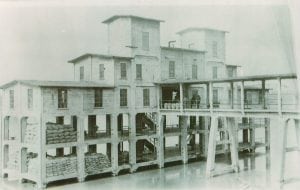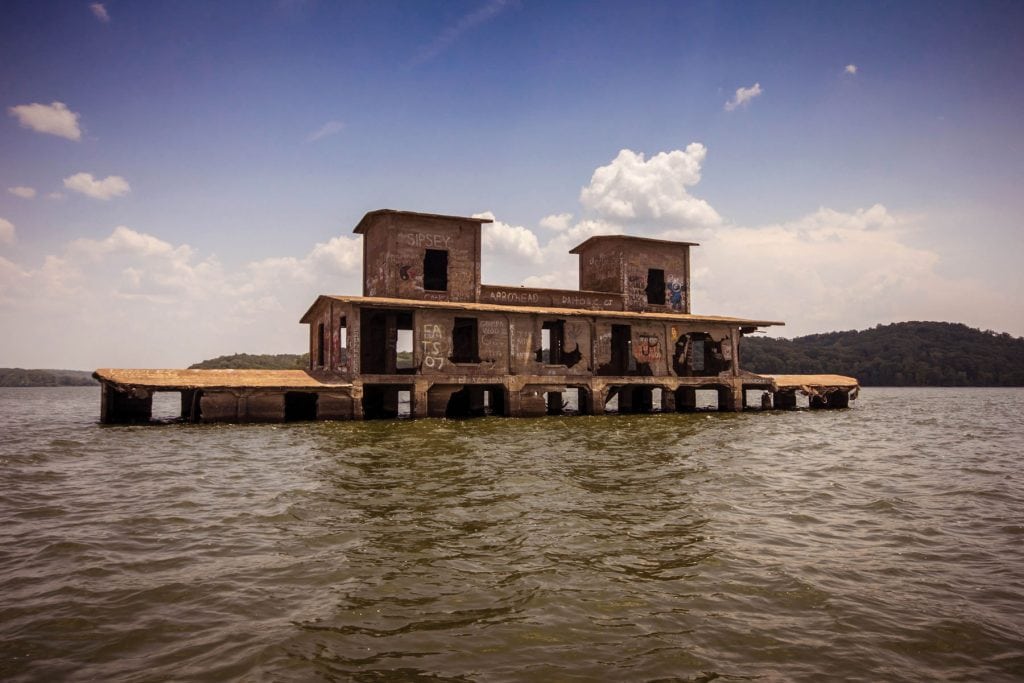To the best of my knowledge, it is the only permanently flooded structure quite like it in Tennessee. However, few of the skiers, sightseers and fishermen who see it, drive around it and even climb on it probably know what it is and why it still stands. A concrete edifice commonly known as the “Danville Grain Elevator” (to history buffs as the “Danville Freight Elevator”) sits in the middle of Kentucky Lake. If ever there was a case study of how a promising place can vanish from the map, this would be it.
A concrete edifice commonly known as the “Danville Grain Elevator” (to history buffs as the “Danville Freight Elevator”) sits in the middle of Kentucky Lake. If ever there was a case study of how a promising place can vanish from the map, this would be it.Danville was once sort of important. The community popped up in the mid-1800s in a relatively narrow section of the Tennessee River at the border of Benton and Stewart counties (Houston County was later carved out of parts of Stewart County).

Danville was once sort of important. The community popped up in the mid-1800s in a relatively narrow section of the Tennessee River at the border of Benton and Stewart counties (Houston County was later carved out of parts of Stewart County). In 1852 — when there was no bridge connecting West Tennessee to Middle Tennessee — engineers from the Memphis, Clarksville and Louisville Railroad decided Danville was the best place to build a bridge across the Tennessee River. It took several years, but the railroad built the bridge, making Danville a critical link between the Ohio River Valley and the Mississippi River. At the time, there would have been a lot of cotton merchants in Memphis and wholesale grocers in Louisville pretty excited about this remote spot on the map.
In 1852 — when there was no bridge connecting West Tennessee to Middle Tennessee — engineers from the Memphis, Clarksville and Louisville Railroad decided Danville was the best place to build a bridge across the Tennessee River. It took several years, but the railroad built the bridge, making Danville a critical link between the Ohio River Valley and the Mississippi River. At the time, there would have been a lot of cotton merchants in Memphis and wholesale grocers in Louisville pretty excited about this remote spot on the map.As Danville’s bridge was being built, its residents probably assumed that their community had arrived. Some may have foreseen that it would one day be a noteworthy city along the river. After all, at the time the Danville Bridge opened, it was the only crossing on the 255 miles of the Tennessee River below Florence, Alabama.
As Danville’s bridge was being built, its residents probably assumed that their community had arrived. Some may have foreseen that it would one day be a noteworthy city along the river. After all, at the time the Danville Bridge opened, it was the only crossing on the 255 miles of the Tennessee River below Florence, Alabama.However — talk about a bad omen — the Danville Bridge opened in April 1861, the very month that the Civil War broke out. Late that year, the Confederate government, recognizing the significance of this junction between river and railroad, stationed a commissary and hospital at Danville.
However — talk about a bad omen — the Danville Bridge opened in April 1861, the very month that the Civil War broke out. Late that year, the Confederate government, recognizing the significance of this junction between river and railroad, stationed a commissary and hospital at Danville.
On Feb. 6, 1862, Ft. Henry and Ft. Heiman (each about 25 miles downstream from Danville) fell to Union forces. After the surrender, four Confederate steamers fled upstream. General Ulysses S. Grant sent a small Union Navy flotilla commanded by Navy Capt. Seth Phelps to chase them down and secure the Danville Bridge.
According to “Ironclad Captain: Seth Ledyard Phelps and the U.S. Navy,” Confederate soldiers were loading equipment and supplies to a train when the Union Navy forces approached Danville. “As the gunboats approached, the train pulled out with the telegrapher, his equipment, and those who did not wish to stay behind.” Union troops secured the small commissary and hospital. For the most part, the bridge remained in Union hands for the rest of the war.
By 1871, the Louisville & Nashville Railroad had taken over what was left of the Memphis, Clarksville and Louisville Railroad. Knowing it would be a great place to transfer freight from rail to river (and vice versa), the L&N built a station in Danville for the loading, unloading and temporary storage of various kinds of freight along with a short railroad spur to connect to the main line.
In 1914, this transfer station was replaced by the steel and concrete freight elevator that remains today. “Many of L&N’s older structures from the 1860s and 1870s were of wood construction and by the turn of the century were being replaced,” says Dennis Mize, author of a 1999 book called “L&N’s Memphis Line: Bowling Green, Kentucky, to Memphis, Tennessee.” “I would not be surprised that an 1872 building needed replacement by 1914.”
Meanwhile, the small community of Danville remained, and it eventually came to contain homes, a few churches and a hotel. But it was never incorporated, and its population never grew larger than about 250 to 300 residents, according to longtime resident Bob McKinnon.
McKinnon says the freight elevator was a lively place. “There was a lot of agricultural products such as corn, cotton and peanuts,” he says. “The peanuts in particular were of interest to kids, who would come and find the ones that maybe had fallen out of the burlap sacks.”
McKinnon says some of the products that would have come through the freight elevator are ones that most people no longer associate with that part of Tennessee. “When they were still heavily harvesting white oak trees, you would see a lot of barrel staves being unloaded and loaded,” he says. “Another thing you would see a lot of was mussel shells, which were being harvested from the bottom of the river and sent as far away as Japan.”
The bridge across the Tennessee River at Danville was rebuilt several times before the railroad constructed a steel “camelback truss” bridge across the river there in 1932. Shortly after that, the Tennessee Valley Authority began building Kentucky Dam and buying all homes and farms it intended to flood to create Kentucky Lake.
It was TVA’s common practice to tear down every building on land it intended to flood. To this day, no one is sure why the agency didn’t tear down the freight elevator.
“There are some people who think they left it there to better mark the channel,” McKinnon says. “But I think they started to tear it down and decided it would be too much trouble because it was so solid.”
The water level rose about 55 feet when Kentucky Lake was created, submerging most (but not all) of the freight elevator.
The railroad line was deactivated through Danville and the bridge dismantled in the early 1980s. “Eventually, it didn’t make sense for the railroad to have two routes to Memphis,” says Houston County Mayor George Clark, who is now in the process of trying to have a park placed near the site.
The strange history of Danville, its riverfront and the abandoned freight elevator building leads to a rather bizarre conclusion: Most of it may be underwater, but this five-story structure is apparently the tallest building (from top to bottom) in Houston County. It is there because Danville, Tennessee, was once an important link between Louisville and Memphis.
That’s certainly something for the people who fish around and from it to contemplate.



